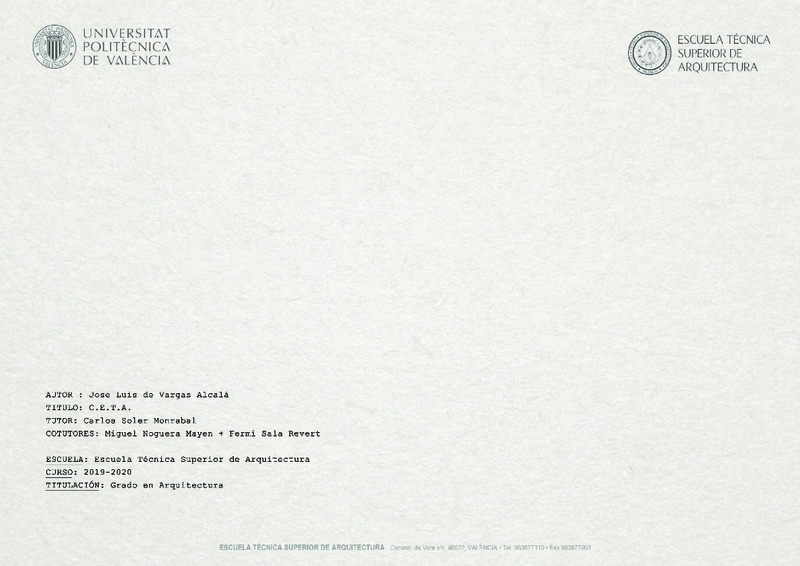JavaScript is disabled for your browser. Some features of this site may not work without it.
Buscar en RiuNet
Listar
Mi cuenta
Estadísticas
Ayuda RiuNet
Admin. UPV
CETA
Mostrar el registro sencillo del ítem
Ficheros en el ítem
| dc.contributor.advisor | Soler Monrabal, Carlos
|
es_ES |
| dc.contributor.advisor | Noguera Mayen, Miguel
|
es_ES |
| dc.contributor.advisor | Sala Revert, Fermí Jacint
|
es_ES |
| dc.contributor.author | Vargas Alcalá, Jose Luis de
|
es_ES |
| dc.coverage.spatial | east=-0.4247626152695938; north=39.50018997054921; name=Calle Canonigo Fenollera, 4, 46035 Valencia, Espanya | es_ES |
| dc.date.accessioned | 2020-12-21T10:53:46Z | |
| dc.date.available | 2020-12-21T10:53:46Z | |
| dc.date.created | 2020-07-27 | |
| dc.date.issued | 2020-12-21 | es_ES |
| dc.identifier.uri | http://hdl.handle.net/10251/157560 | |
| dc.description.abstract | [ES] El centro de estudios tecnológicos se instala en un solar situado en el extremo suroeste de Benimámet(Valencia). El complejo de edificios docentes se sitúan próximos a la estación de metro `Les Carolines", delimitados por la ronda de circunvalación y rodeados de huerta. Una extensa red de amplios paseos peatonales envolverán al complejo docente garantizando la tranquilidad, silencio y aislamiento requerido. El objetivo específico del proyecto será el de contribuir al beneficio general de la sociedad y a la mejora de la competitividad de las empresas mediante la formación de conocimiento tecnológico en los jóvenes. El fin último radicará en crear un espacio que sirva como referencia en el plano socio/cultural, permitiendo potenciar y connsolidar el tejido social, activo y participativo y en última instancia, reforzar el desarrollo social y cultural. Aislado del resto de edificios y rodeado por una vía de intenso tráfico, el complejo CETA deberá garantizar por sí mismo: una zona verde, espacio exterior, aire, luz y un ambiente propicio para impartir docencia. El crecimiento desordenado de nuestras ciudades, genera desigualdades sociales, lo cual requiere planificación y diseño; para ello los arquitectos disponemos de herramientas con las que resolver y paliar estas realidades. En este contexto conflictivo debemos valorar todas aquellas iniciativas que apunten a facilitar a todas las personas una mejor inserción social y laboral. Objetivos específicos: -Fomentar el emprendimiento y Empleo de los jóvenes. -Reforzar el tejido asociativo del barrio -Crear espacios de convivencia promoviendo acciones de ocio, cultura, sensibilización y participación ciudadana. -Fortalecer la inclusión en igualdad, promoviendo acciones que visibilicen la diversidad existente en el barrio. | es_ES |
| dc.description.abstract | [EN] The technological studies center is installed in a plot located in the southwest corner of Benimamet (Valencia). The complex of educational buildings are located next to the metro station Les Carolines delimited by the ring road and surrounded by vegetable garden. An extensive network of wide pedestrian promenades surrounding the teaching complex guaranteeing the tranquility, silence and isolation required. The specific objective of the project will be the general benefit of society and the improvement of the competitiveness of companies through the training of technological knowledge in young people. The ultimate goal will be to create a space that serves as a reference on the socio / cultural context, the empowerment and consolidation of the social layer, active and participatory and ultimately, the defense of social and cultural development. The content of the building it ́s a road of intense traffic, the CETA complex must be likewise: a green zone, outer space, air, light and an environment conducive to teaching. The disorderly growth of our cities generates social inequalities, which requires planning and design. For this, architects have tools to solve and mitigate these realities. In this context, we have to value all social networks. Specific objectives: -To promote the development and employment of young people. -Reinforce the associative layer of the neighborhood -Creating spaces of coexistence promoting leisure activities, culture, awareness and citizen participation. -Foster the inclusion in equality, promoting actions that make visible the existing diversity in the neighborhood. | es_ES |
| dc.format.extent | 192 | es_ES |
| dc.language | Español | es_ES |
| dc.publisher | Universitat Politècnica de València | es_ES |
| dc.rights | Reserva de todos los derechos | es_ES |
| dc.subject | Innovación | es_ES |
| dc.subject | Docencia | es_ES |
| dc.subject | Tecnología | es_ES |
| dc.subject | Innovation | es_ES |
| dc.subject | Teaching | es_ES |
| dc.subject | Proyectos arquitectónicos | es_ES |
| dc.subject | Architectural projects | es_ES |
| dc.subject | Centros educativos | es_ES |
| dc.subject | Schools | es_ES |
| dc.subject | Centro de estudios tecnológicos | es_ES |
| dc.subject | Technological Studies Center | es_ES |
| dc.subject | Benimámet (Valencia) | es_ES |
| dc.subject.classification | PROYECTOS ARQUITECTONICOS | es_ES |
| dc.subject.other | Grado en Arquitectura-Grau en Arquitectura | es_ES |
| dc.title | CETA | es_ES |
| dc.type | Proyecto/Trabajo fin de carrera/grado | es_ES |
| dc.rights.accessRights | Abierto | es_ES |
| dc.description.bibliographicCitation | Vargas Alcalá, JLD. (2020). CETA. Universitat Politècnia de València. http://hdl.handle.net/10251/157560 | es_ES |
| dc.description.accrualMethod | TFGM | es_ES |
| dc.relation.pasarela | TFGM\114405 | es_ES |
Este ítem aparece en la(s) siguiente(s) colección(ones)
-
ETSA - Trabajos académicos [4687]
Escuela Técnica Superior de Arquitectura






